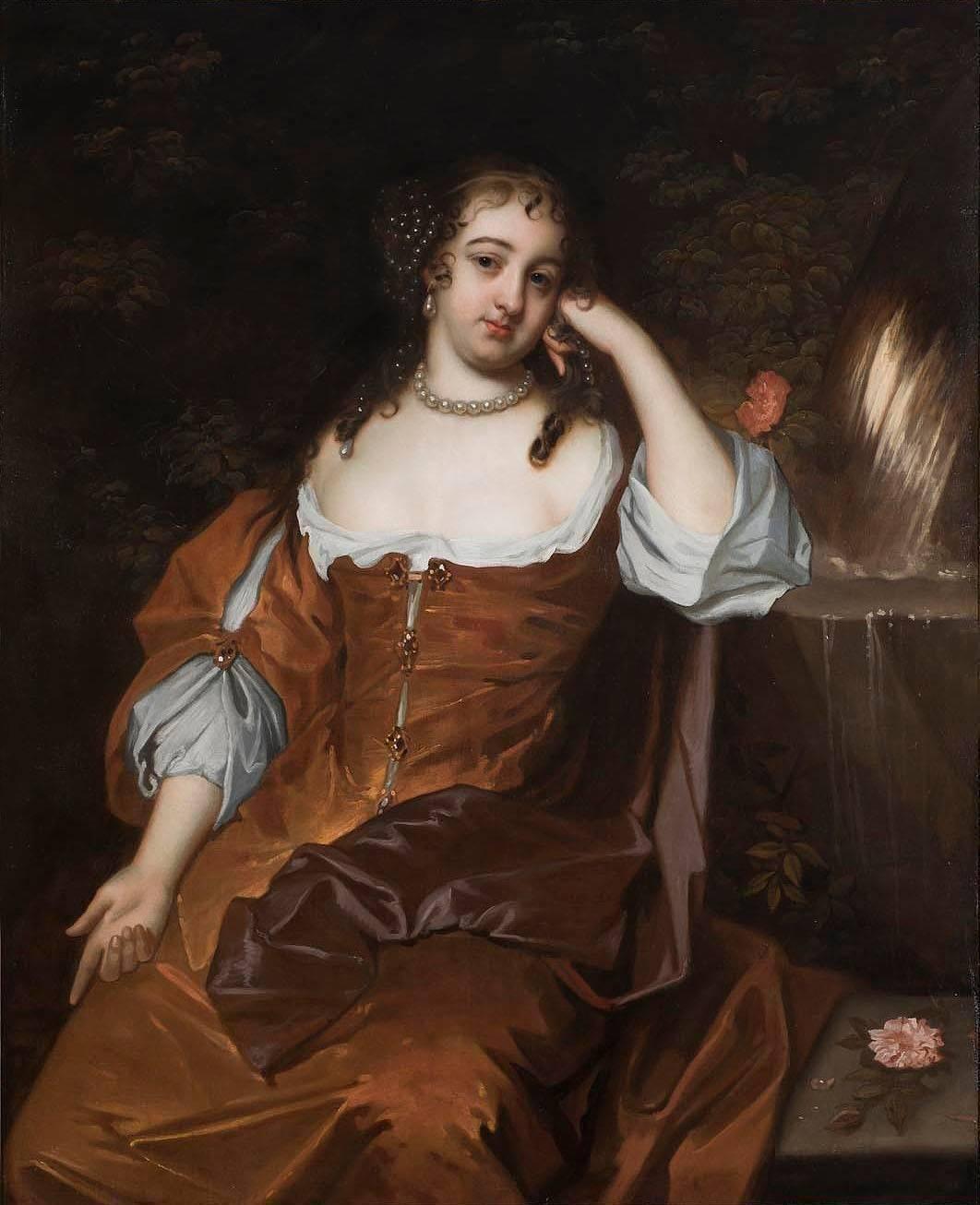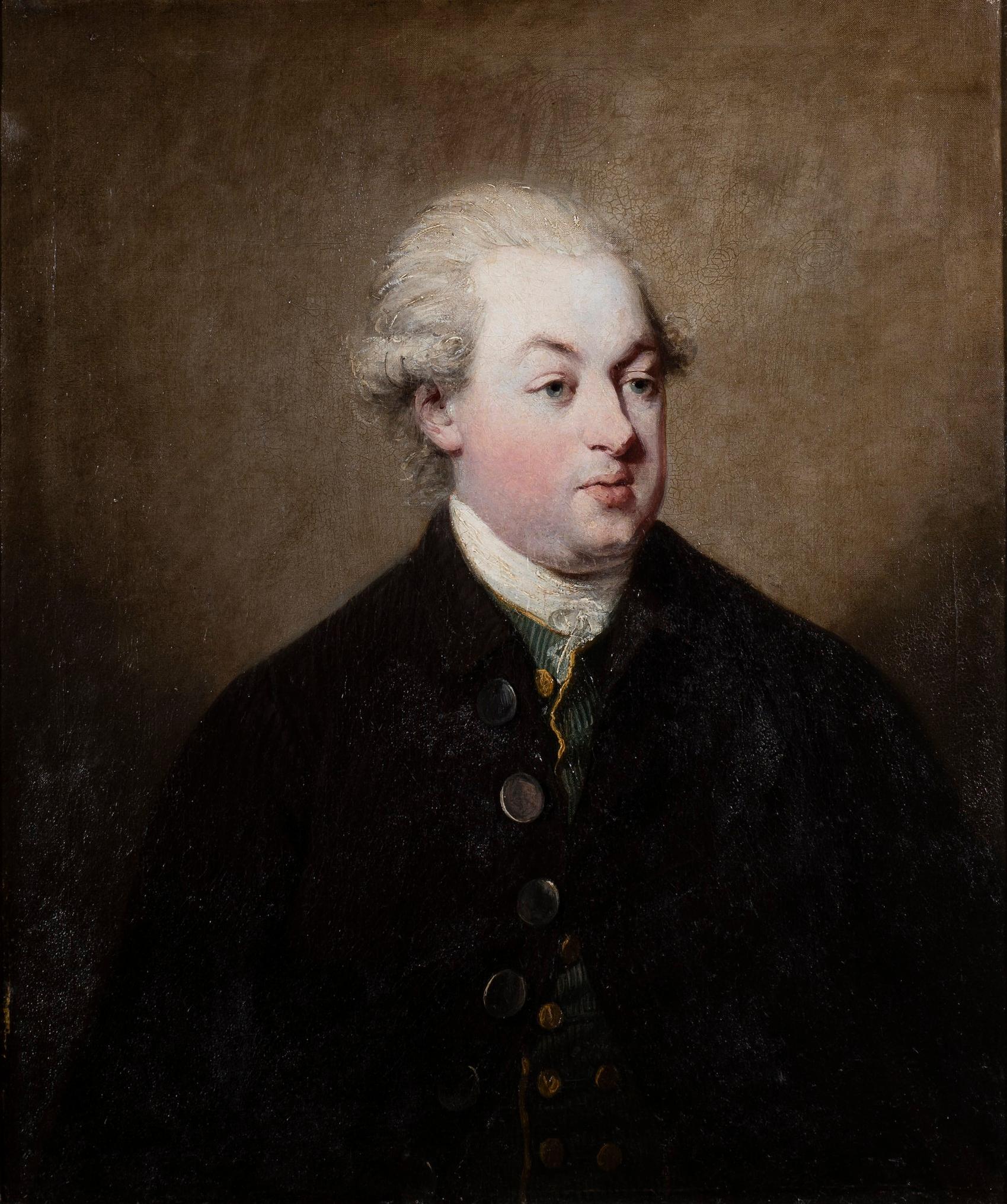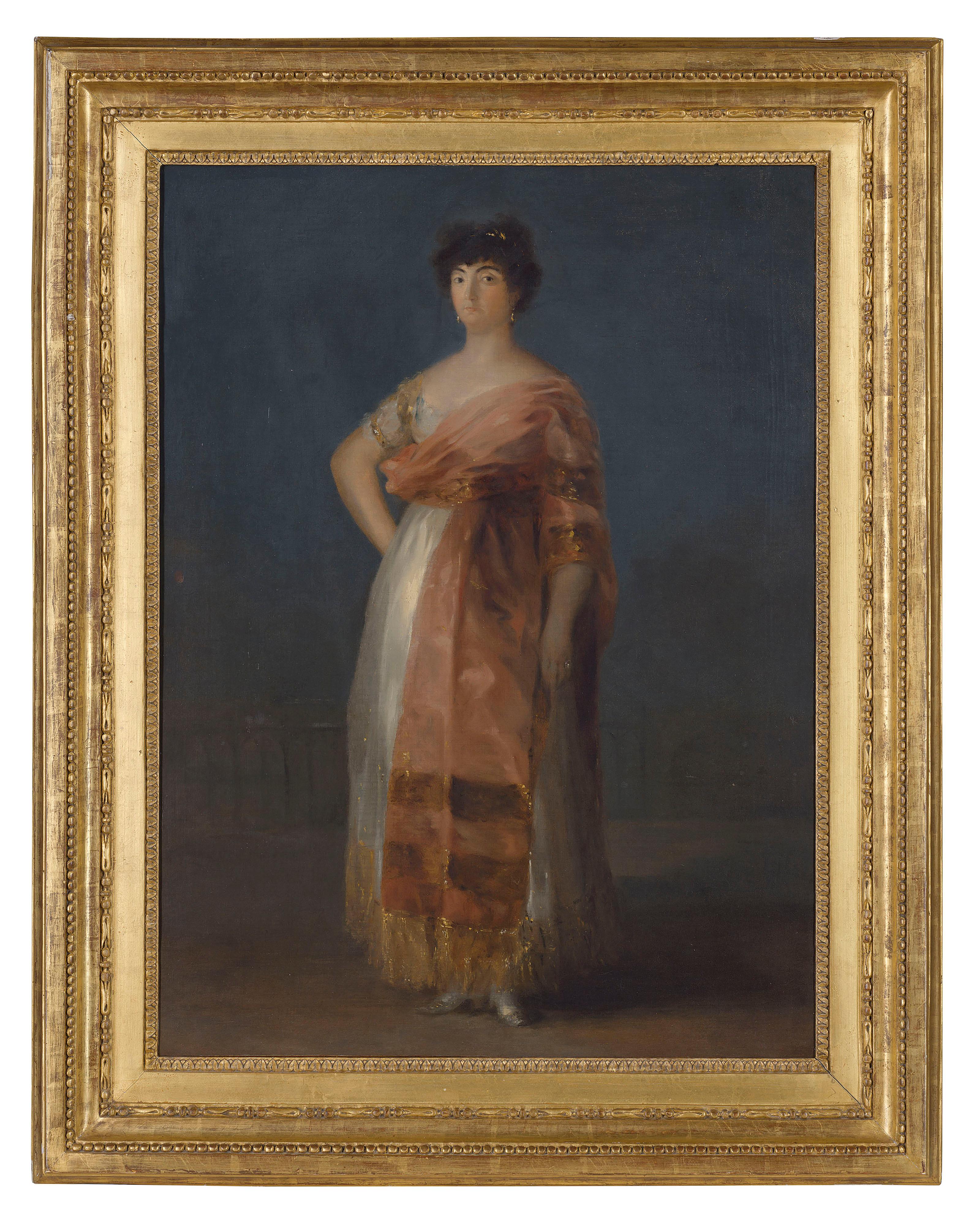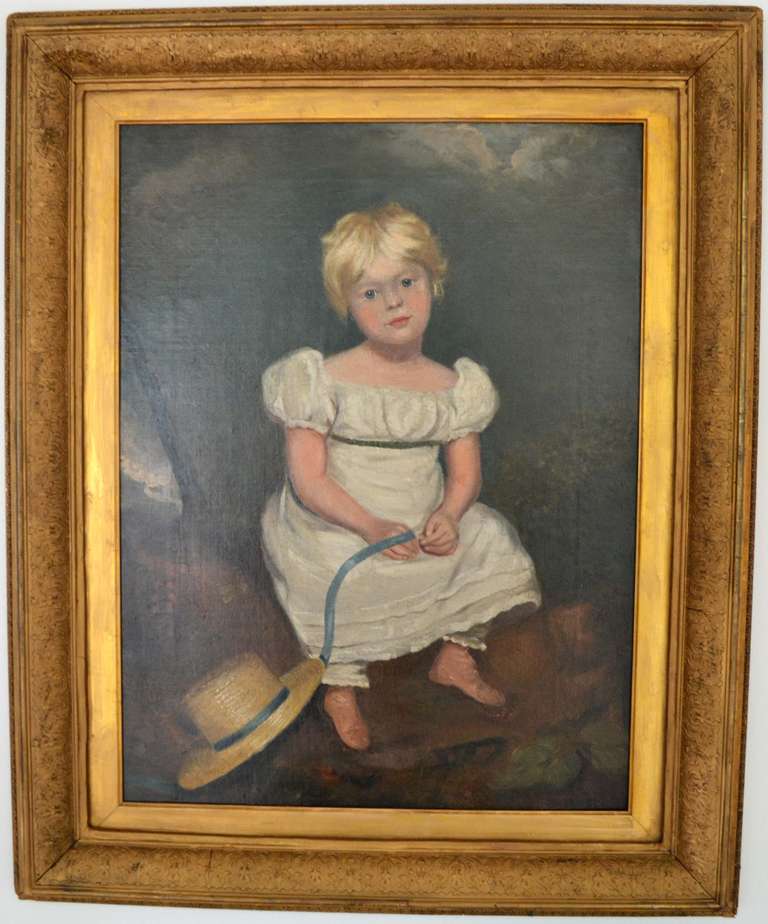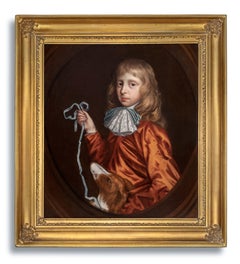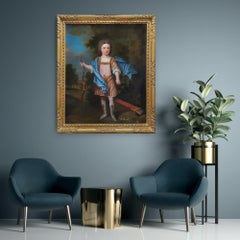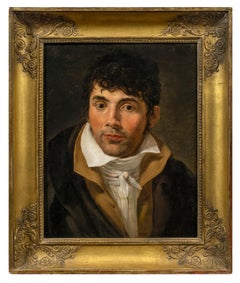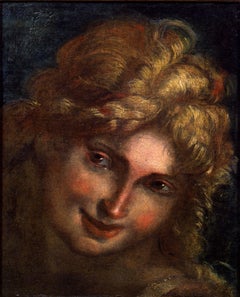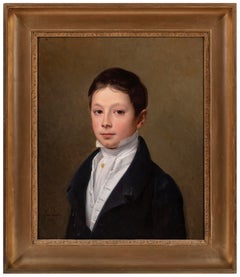
Portrait of the Countess de Montdidier circa 1672, Antique oil Painting
View Similar Items
Want more images or videos?
Request additional images or videos from the seller
1 of 12
Portrait of the Countess de Montdidier circa 1672, Antique oil PaintingCirca 1672
Circa 1672
About the Item
- Attributed to:Henri Gascar (1634 - 1701, French)
- Creation Year:Circa 1672
- Dimensions:Height: 44.89 in (114 cm)Width: 36.62 in (93 cm)Depth: 3.35 in (8.5 cm)
- Medium:
- Movement & Style:
- Period:
- Condition:Good condition. All our items pass a quality test by our conservators to ensure the condition is good prior to going on sale. This painting can be hung and enjoyed immediately.
- Gallery Location:London, GB
- Reference Number:1stDibs: LU119918376562
About the Seller
5.0
Vetted Seller
These experienced sellers undergo a comprehensive evaluation by our team of in-house experts.
Established in 1998
1stDibs seller since 2019
30 sales on 1stDibs
Typical response time: 1 hour
More From This SellerView All
- Portrait of a Young Gentleman and Pet Dog c.1680, Antique oil on Canvas PaintingBy (Circle of) Mary BealeLocated in London, GBThe portrait genre was valued particularly highly in English society. Neither landscapes nor allegorical pictures were ever priced so highly at exhibitions and in the trade as depictions of people, from the highest aristocracy to scholars, writers, poets and statesmen. This charming portrait, presented by Titan Fine Art, of a fashionable young gentleman and his faithful pet is an excellent example of 17th century child portraiture in England. There is a remarkable beauty and sensitivity to the portrait. The face, particularly well rendered, has captured the character of this young man – both charming and at the same time mischievous. Only the playful attention of a small dog suggests anything less than patrician dignity. Symbolism was important in portraiture and it provided a pointed and aspirational narrative that would not have been lost on contemporary viewers. For example, the presence of the dog, which was likely the boy’s pet, is at once a charming pictorial device and also a clear allusion to fidelity, trust and loyalty. The hairstyle and the attire, notably the type of cravat with the blue ribbon, help to date this portrait to between 1670 to 1685. Until the late eighteenth century children were dressed as adults - boys were dressed like men in breeches, vests, and coats between four and seven years of age. The expensive lace is an indication to his family’s wealth. Held in a good quality and condition antique gilded frame. Born in Suffolk, Mary Beale, nee Cradock (1633-1699) was employed by many of the most distinguished persons of her time including nobility, landed gentry, and clergymen. Technically accomplished, her paintings are noteworthy for their honest and sympathetic portrayal. In 1651 she married Charles Beale...Category
17th Century Old Masters Portrait Paintings
MaterialsCanvas, Oil
- Portrait of Young Gentleman, Lord George Douglas, Arcadian Landscape c.1710Located in London, GBPortrait of Young Gentleman, Lord George Douglas, in an Arcadian Landscape c.1710 Attributed to Charles D'Agar (1669-1723) Depicted with bow in hand and situated against an Arcadian...Category
18th Century Old Masters Portrait Paintings
MaterialsCanvas, Oil
- Portrait of Lady, Grace Saunderson, Viscountess Castleton Oil on canvas PaintingBy Studio of Sir Peter LelyLocated in London, GBPortrait of Grace Saunderson, Viscountess Castleton (1635-1667) c.1665-67 Sir Peter Lely and Studio (1618-1680) Titan Fine Art present this work, which formed part of a collection of family pictures and heirlooms of the Saunderson, Viscount Castleton family and their descendants, the Earls of Scarbrough, at their magnificent family seat Sandbeck Park, where the Earls still reside today almost four hundred years later. It was painted in the studio of Sir Peter Lely...Category
17th Century Old Masters Portrait Paintings
MaterialsCanvas, Oil
- Pair (2) Portraits Gentleman & Lady, William & Rachel Helyar c.1656, Civil WarBy Robert WalkerLocated in London, GBPortrait of Colonel William Helyar (1621-1698) and Rachel Helyar (c.1633-1678) c.1656 Circle of Robert Walker (act. 1637-1656) These fascinating portraits, presented by Titan Fine Art, depict Colonel William Helyar, High Sheriff of Somersetshire, and his wife Rachel Helyar nee Wyndham, a daughter and co-heiress of Sir Hugh Wyndham, 1st Baronet (died 1663) of Pilsden Court, Dorset. They are exquisite examples of portraiture during the Interregnum when England was under various forms of republican government. The history of the seventeenth century is in part the story of the Stewarts and their approach to government and the church; their ebbing and flowing popularity and the disastrous decisions that led to Civil War. But another fascinating dynasty also ruled Britain: the Cromwell’s. Between 1653 and 1659, following the Civil Wars and experimental Commonwealth, Oliver Cromwell governed as Lord Protector followed by his son Richard. Cromwell’s Protectorate is usually imagined as a grey, joyless, military regime. But the reality was rather different. Cromwell presided over a colourful and fashionable court where music and the arts flourished, masques were revived and the first English operas performed. Too often the London of the 1650s is painted as puritanical and repressive in contrast to the vivid, fun-loving capital of the Restoration. Yet, under Cromwell, this was the city where the first coffee houses were opening, where a young Samuel Pepys was embarking on his career as a civil servant with the patronage of one of Cromwell’s councillors and where Christopher Wren was enjoying his new Chair of astronomy at Gresham College, appointed after the personal intervention of Cromwell. When Cromwell was invested as Lord Protector for the second time in 1657, the lavish ceremony in Westminster Hall and procession through London matched any previous coronation for pageantry with thousands lining the streets, bells ringing, bonfires blazing and free French wine flowing through the city. The gentleman in our portrait is Colonel William Helyar (1621-1698), Sheriff of Somerset and as a Royalist during the English Civil War. As one of the most prominent old families of the South-West, the Helyar’s family roots in Somerset can be traced back to 1616 when the Reverend William Helyar (1559-1645), chaplain to Elizabeth I, who was also a cousin by marriage, purchased the family residence Coker Court in East Coker, Somerset. He married a Devonshire heiress and several estates were bestowed on him as a result. He was a warm supporter of Charles I in the Civil War and was in residence at Exeter in 1643 when the Parliamentarians pillaged the cathedral. Elderly as he was, he boldly resisted them, but was beaten, pelted with mud, and locked up in a ship in the port and only let out on payment of £800. He retired to Coker where he died in 1645. His eldest son Henry died in 1634 and he was succeeded by his grandson, Colonel William Helyar, the sitter in our portrait. Colonel Helyar raised a troop of horse for King Charles I and was a colonel in the king's army. He was at Exeter when it was captured by the Parliamentary forces in 1646 and thus deemed ‘Traitor to the Parliament’. His estates were sequestered, but they were returned and he was discharged and pardoned on payment of £1,522. During the Restoration he was a Sheriff and he also helped James II repel the Monmouth Rebellion. The companion portrait represents the Colonel’s wife, Rachel Helyar (baptised 24th June 1633 at St Mary Aldermanbury, London – died 1678). She was the youngest daughter and co-heir of Sir Hugh Wyndham, 1st Baronet of Pilsdon Court and Mary Wyndham nee Alanson (Sir Hugh should not be confused with his first cousin once removed from Somerset, also Sir Hugh Wyndham (bef. 1604 - 1684). Rachel is a thirteenth generation descendant of King Henry III. The couple resided at the family seat of Coker Court (interestingly, within the churchyard, lie the remains of the poet T.S. Eliot who once wrote a poem about East Coker). A marriage settlement in extant shows that the couple were married in 1656; the portraits were most likely painted to mark this important event in the sitter’s lives. Rachel holds roses, the flower of love, and the putto pouring water is representative of her purity, and possibly, the plighting of troth. Colonel Helyar wears a gold wedding band. The couple had four sons: George, William (MP) (1662-1742), John, and Richard. Colonel Helyar died in December 1697 and was buried at Whitechurch, Dorset 2 Jan 1698. This period in which this portrait was painted was known as the Protectorate (1653-1659). This period offered relative peace, as the English Civil War ended in 1651. It was an interesting time for portraiture in England and Scotland – in between the great artistic geniuses and dominance of Van Dyke and Peter Lely. Much of the foreign-born artistic talent had fled England and Scotland during the Civil War and the artists that had remained were in great demand, in part due to the newly exposed strata of society wishing to be painted. Sitters on both sides were depicted in portraits in very similar ways. They are not, on the whole, shown as the Roundheads and Cavaliers of popular history. In fact, it is usually impossible to guess their political allegiances from the style of their portrait and their Parliamentarian and royalist iconographies, as portraits on both sides followed the same conventions and looked identical. Colonel Helyar has been depicted in armour and holding a Marshal’s baton of command, confirming his status. There is a great sense of realism and a particular delicacy, note the finely rendered hand resting on the rapier. Rachel is wearing a satin dress with expansive sleeves and a crimson drapery over her shoulder and held up by her left hand. She wears large pearl...Category
17th Century Old Masters Portrait Paintings
MaterialsCanvas, Oil
- Pair (2) of English Portraits, Lady in Blue Dress & Lady in Red Dress c.1720By Jonathan Richardson the ElderLocated in London, GBThese beautiful portraits were painted circa 1725 and are fine examples of the English eighteenth century portrait style. One sitter has been depicted wearing a simple blue silk dress and the other wears a red silk dress and a silk drapery in her hair. The artist utilised a restrained manner and chose to depict the subjects without jewellery or artificial adornments, and against plain backgrounds. Instead, the viewer can focus solely on the beauty of the sitters and the considerable talent of the artist. The effect achieved is of understated elegance. The portrait genre was valued particularly highly in English society. Neither landscapes nor allegorical pictures were ever priced so highly at exhibitions and in the trade as depictions of people, from the highest aristocracy to scholars, writers, poets and statesmen. With the rich colouring and lyrical characterisation, these works are representative of the archetypal English portrait and is are very appealing examples of British portraiture. Contained within fine gilded antique frames. Jonathan Richardson...Category
18th Century Old Masters Portrait Paintings
MaterialsCanvas, Oil
- Portrait of a Gentleman in Armour and Mauve Cloak c.1740; Louis Tocque, PaintingLocated in London, GBThe sitter in this superb portrait, presented by Titan Fine Art, is shown with the grandiloquence characteristic of the eighteenth-century French school of painting. The young nobleman has been portrayed wearing an ingeniously embellished French ceremonial armour, a mauve cloak, and an abundance of cascading curls falling below his shoulders. Our portrait proclaims to every onlooker that this is a superior being. The manner in which portraits were painted was set out by the terms of the commission and usually marked significant life events such as a betrothal, a death, elevation of rank… but they almost always emphasised the wealth and importance of the sitter. This type of portrait had become a standard format for aristocratic portraiture in Europe during the last quarter of the seventeenth century up to the middle of eighteenth century. Incorporated into the background was often a raging battlefield or a military encampment; our portrait is free from these trappings and contains a dramatic moody sky ensures the viewer focuses mainly on the subject. The features of the sitter’s face have been captured with great sensitivity, his confident gaze perhaps reflecting the near invincibility afforded by this steel suit. The flamboyance and penetrating sense of character, lending an air of noble expectancy to the composition, seems almost eclipsed by the artist's virtuosic handling of paint. It is not hard to understand why many wealthy sitters commissioned the artist to paint their portraits. Such fine and ornate armour was not actually used on a battlefield and thus its portrayal in portraiture was largely symbolic of a sitter’s wealth and status as well as a claim of succession to a chivalrous tradition. The style of hair and neckcloth were fashionable circa 1740. Held in an exquisite eighteenth century carved and gilded frame - a fine work of art in itself. Louis Tocqué was a very successful French portrait painter active during the Rococo period of art. His work was known for its attention to detail, its portrayal of the character of the sitter, the refined postures, and the delicacy of the rendered draperies. He created both realistic and expressive portraits. Tocqué was born in Paris in 1696 and trained with the famous portrait painters Hyacinthe Rigaud, Nicolas Bertin, and Jean Marc Nattier whose daughter he later married. He entered the Academy in 1731 and became a full member in 1734 with his portraits of Galloche and the sculptor Jean Louis Lemoine, and he pursued a brilliant career as a portrait painter, receiving numerous commissions from members of the French aristocracy and royalty. His works were highly sought after by collectors of the time, and his reputation earned him the appointment of official portrait painter to the court of France in 1746 – in fact he stayed at most of the courts in northern Europe. From 1737 to 1759 he exhibited a large number of works at the Salon. Tocqué's paintings can be found in museums and private collections around the world. Recent sales...Category
18th Century Old Masters Portrait Paintings
MaterialsCanvas, Oil
You May Also Like
- Portrait of a GentlemanLocated in New York, NYCircle of Jacques-Louis David (French, 18th Century) Provenance: Private Collection, Buenos Aires Exhibited: “Art of Collecting,” Flint Institute of Art, Flint, Michigan, 23 November 2018 – 6 January 2019. This vibrant portrait of young man was traditionally considered a work by Jacques-Louis David, whose style it recalls, but to whom it cannot be convincingly attributed. Rather, it would appear to be by a painter in his immediate following—an artist likely working in France in the first decade of the nineteenth century. Several names have been proposed as the portrait’s author: François Gérard, Louis Hersent, Anne-Louis Girodet (Fig. 1), Theodore Gericault, and Jean-Baptiste Wicar, among others. Some have thought the artist Italian, and have proposed Andrea Appiani, Gaspare Landi...Category
18th Century Old Masters Paintings
MaterialsCanvas, Oil
$45,000 - Head of an AngelLocated in New York, NYProcaccini was born in Bologna, but his family moved to Milan when the artist was eleven years old. His artistic education was evidently familial— from his father Ercole and his elder brothers Camillo and Carlo Antonio, all painters—but his career began as a sculptor, and at an early age: his first known commission, a sculpted saint for the Duomo of Milan, came when he was only seventeen years old. Procaccini’s earliest documented painting, the Pietà for the Church of Santa Maria presso San Celso in Milan, was completed by 1604. By this time the artist had made the trip to Parma recorded by his biographers, where he studied Correggio, Mazzola Bedoli, and especially Parmigianino; reflections of their work are apparent throughout Procaccini's career. As Dr. Hugh Brigstocke has recently indicated, the present oil sketch is preparatory for the figure of the angel seen between the heads of the Virgin and St. Charles Borrommeo in Procaccini's altarpiece in the Church of Santa Afra in Brescia (ill. in Il Seicento Lombardo; Catalogo dei dipinti e delle sculture, exh. cat. Milan 1973, no. 98, pl. 113). As such it is the only known oil sketch of Procaccini's that can be directly connected with an extant altarpiece. The finished canvas, The Virgin and Child with Saints Charles Borrommeo and Latino with Angels, remains in the church for which it was painted; it is one of the most significant works of Procaccini's maturity and is generally dated after the artist's trip to Genoa in 1618. The Head of an Angel is an immediate study, no doubt taken from life, but one stylistically suffused with strong echoes of Correggio and Leonardo. Luigi Lanzi, writing of the completed altarpiece in 1796, specifically commented on Procaccini's indebtedness to Correggio (as well as the expressions of the angels) here: “Di Giulio Cesare...Category
17th Century Old Masters Figurative Paintings
MaterialsCanvas, Paper, Oil
- Portrait of a Young BoyLocated in New York, NYSigned and dated, lower left: Louise Hersent/ 1823 Provenance: Private Collection, Chicago, by 1996 Private Collection, Florida This charming portrait of a young boy is the work of Louise-Marie-Jeanne Hersent, a little-known woman artist of the French Restoration often identified by her maiden name, Mauduit. While Hersent—as we will call her here following the signature on the painting—has been understudied, the known details of her life and career reveal that she held a privileged position in artistic life in the early nineteenth century in Paris. She exhibited at the Salon from 1810 until 1824, and in 1821 she married the painter Louis Hersent, a successful pupil of Jacques-Louis David who was patronized by Louis XVIII and Charles X. It is likely through her husband’s royal patronage that Hersent’s Louis XIV Visits Peter the Great was purchased for the Royal Collection in Versailles. In 1806, while still Louise Mauduit, she painted a portrait of Napoleon’s youngest sister, Pauline Bonaparte...Category
1820s Old Masters Paintings
MaterialsCanvas, Oil
- Portrait of a Lady, 17th Century Flemish Oil Old MastersBy Jacob HuysmansLocated in London, GBJacob Huysmans Flemish 1633 - 1696 Portrait of a Lady Oil on canvas Image size: 49 x 40 ¼ inches Gilt frame Huysmans was born in Antwerp and came to England during the reign of Charles II where he became one of the fashionable painters of the court.. The diarist Samual Pepys noted the artist as capable of a more exact likeness than Lely. Certainly the diarist records that by August 1664 in the circle of Queen Catherine...Category
17th Century Old Masters Portrait Paintings
MaterialsCanvas, Oil, Acrylic
- 18th c. French Portrait of Princess of Bourbon as Hebe, Pierre Gobert, c. 1730By Pierre GobertLocated in PARIS, FRPortrait of Princess of Bourbon as Hebe Pierre Gobert, circa 1730 Presumed portrait of Elisabeth Thérèse Alexandrine of Bourbon-Condé, Mademoiselle de Sens, depicted as the goddess Hebe kidnapped by Zeus, transformed into an eagle. 18th century French School, around 1730 Pierre Gobert (1662-1744) and workshop Oil on canvas Dimensions: canvas: h. 129 cm, w. 95cm Dimensions: framed: h. 156 cm, w. 124cm Louis XIV style giltwood and cardved wood frame Large and imposing portrait of the young princess portrayed seated on an eagle in the heavens. Seen from the front, the princess is dressed in a low-cut white chiffon dress, exposing her throat. Delicately made-up oval face, dominated by large blue-gray eyes is surrounded by powdered hair, raised, releasing the forehead and the ears, and of which some locks fall on his shoulder. A large blue scarf passed over the shoulder covers her knees and flies in the wind. A garland of flowers coming from the back goes over the knees and down again on the eagle. In her right hand she holds a golden goblet and in her left hand an ewer. The eagle supporting the young woman seizes in its claws the thunderbolt (the beam of fiery lightning), the attribute of Zeus. The figure of the young woman is enlivened by the fluidity of the antique drapes...Category
Early 18th Century Old Masters Portrait Paintings
MaterialsCanvas, Oil
$23,379 Sale Price20% Off - 19th century portrait painted in St Petersburg in 1819Located in London, GBSigned, inscribed and dated, lower right: 'Geo Dawe RA St Petersburgh 1819', also signed with initials, lower centre: 'G D RA'; and signed and inscribed verso: 'Geo Dawe RA Pinxit 1819 St Petersburgh'; Also inscribed on the stretcher by Cornelius Varley with varnishing instructions. Collections: Private collection, UK, 2010 Literature: Galina Andreeva Geniuses of War, Weal and Beauty: George Dawe...Category
19th Century Old Masters Portrait Paintings
MaterialsCanvas, Oil
Recently Viewed
View AllMore Ways To Browse
Lovers Antique Painting
Embroidery Figure
Antique White Painted French Mirror
Painted Corset
Antique Paintings Mythological
Suiting Dress
Antique Mirror With Oil Painting
King English Landscapes Oil
Hand Painted Gilded Antique Mirror
Antique Dutch Oil Portrait
17th Century Hand Carved Mirror
Le Le Lac
Le Lac
St Petersburg Mirror
Antique Corset
Corset Antique
Antique Continental Mirrors
Charles James Dress



